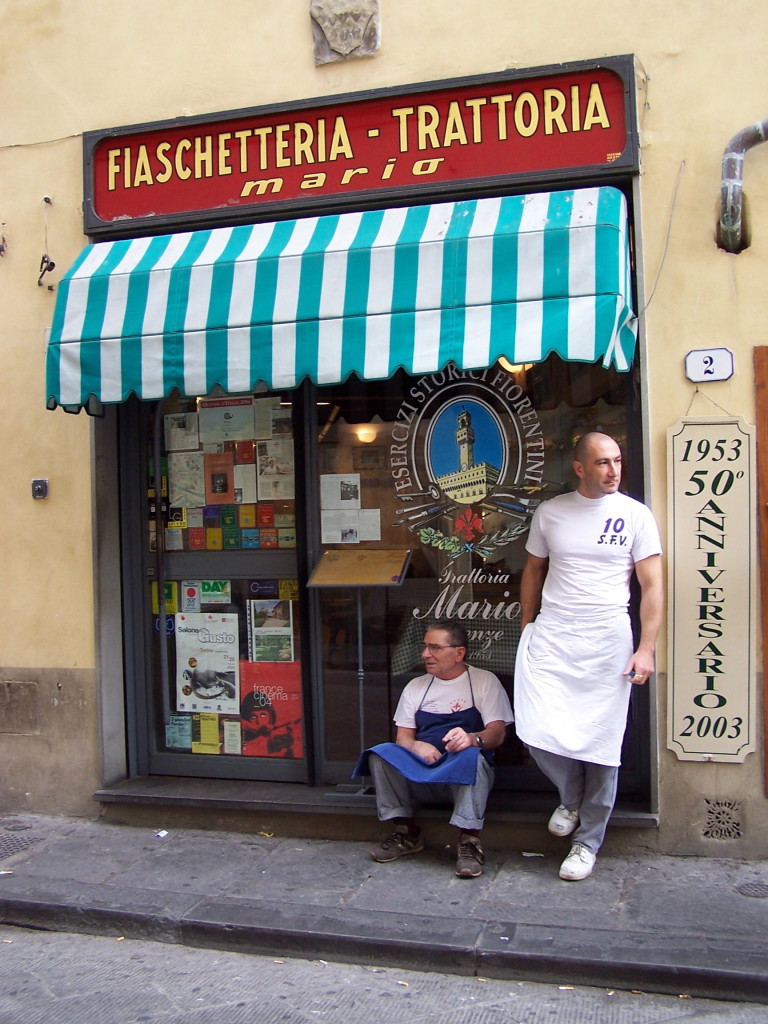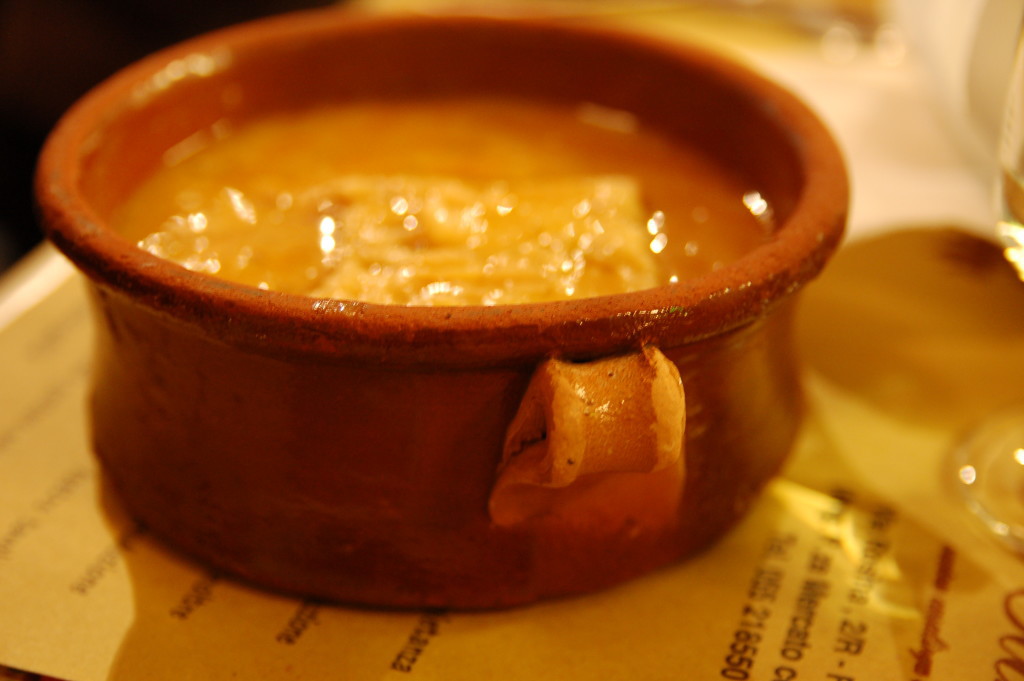Trattoria Mario’s is a home away from home for almost all the students that come to the study abroad programs in Florence. This tiny family trattoria began as a fiaschetteria 4 generations ago. These small family trattorias, passed from one generation to another, are national treasures.In 2013, they celebrated 60 years of their opening. I lived around the corner from the trattoria for 20 years, so this was my go to place for lunch. It is ALWAYS crowded. Just excuse your self and push to the front to leave your name with Fabio at the door.

When I first ate at Mario’s, Romeo’s mother, Elena Colzi, was in the kitchen. She was a true Tuscan mamma cooking for all of us. When she retired, Romeo stepped right in and kept up the same fabulous food standards, cooked with passion and love for food!
Many of the famous old Florentine trattorias have changed hands and are now Chinese restaurants or fast food joints. In honor of those who have held on to tradition and did not sell out, I wish to honor the Colzi family. Romeo and his brother Fabio run the trattoria with Romeo’s wife Patrizia and their children Carolina and Francesco. They preserve a way of life and quality that we all search for. Mario’s is a real slice of Florentine life. For more history, visit their web site.
Mario’s feeds the locals, tourists, and students from abroad, all elbow to elbow. Here, food and friendship go hand in hand. Stop by and join the family! Everyday has specials, so you’ll want to eat here all week just to try them all! It also has a fabulous wine cantina, so if you want to have a special wine here, ask! we usually order a Castello di Ama wine.

Ingredients
- Step 1
- Zuppa di Verdura
- 2 red onions, finely chopped
- 1 pound cooked white beans and the cooking water
- 1 cabbage (in season), sliced and chopped
- 4 celery stalks, sliced
- 1/2 cup parsley leaves, chopped
- 4 carrots, sliced
- 1 small bunch of basil, leaves torn
- 2 tablespoons tomato paste
- Oregano
- Pepper or chili pepper
- Coarse ground sea salt
- Olive oil
Instructions
- Sauté onion in olive oil for 20 minutes until cooked.
- Add a ladle of the cooking water from the beans and let stew.
- Add the cabbage, celery, parsley, carrot, and basil to this mixture.
- Cook for 20 minutes, covered.
- Add the beans, half pureed, the rest whole and the liquid.
- Stir.
- Add tomato paste, oregano, and season to taste with salt and pepper or chili pepper.
- Add water and cook for 90 minutes.
- This is not meant to be thick soup, as later it will be thickened with the bread.
Step Two
The secret to all of the Tuscan bread soups, is recycling the unsalted stale bread. It is hard to find outside of Tuscany and hard to recreate the texture. The stale bread, when soaked in liquid, crumbles into grains like couscous. In America, I find that unseasoned croutons are the closest thing we have to a real stale bread. When I first learned how to make ribollita, they also gave the recipe to make the Tuscan bread to let it go stale. Think about it! Perhaps just toasting some country-style bread would also change the texture.
Let the soup rest at least a day. Layer the soup with thin slices of day old bread.
Heat while stirring until the bread breaks apart and becomes a cream.
Add more water or bean broth if you have it. When the soup is done, turn off the heat and stir in some olive oil.
Taste for salt.
Serve with an extra drizzle of olive oil on top.
Trattoria Mario
Via Rosina,2/r
Just behind the Mercato Centrale
(san lorenzo market) in piazza del mercato
open for lunch- monday to saturday

What a beautiful tribute! I love ribollita and can’t wait to try out this recipe- Thanks Judy! 🙂
thanks heather! that was quick– and i do appreciate the comment!
Thank you for posting this, Judy. Can’t wait to try it! I think that you are an Italuan national treasure who gives friend in the US so many ways to feel the love from Italian cucinas!
thanks Christine!
Thank you, Judy for posting this so quickly!
Mario’s was like a second home for me and my friends while studying abroad–so many years ago now. Still hold such a fondness for the memories made at that cozy trattoria…and oh that ribollita! With this recipe, I’ll be able to summon a bit of Firenze in California.
GREAT– i will pass this on to the family when i pass by!!! hard to believe but it only gets busier!
Mmm…love ribollita! Sounds like a wonderful recipe! Have just bookmarked it for future reference. You have a lovely blog, by the way!
thank you so much– enjoy the recipes!
This is wonderful! I am so happy you are sharing this recipe with us. I spent 5 days in Florence last year and went to Mario’s. I was seated with 2 friendly Romans and one of them made me taste his meal that was looking so nourishing and it turned out it was ribollita. I ordred some and the day after I ate another one at La Casalinga. I’m so happy I will be able to make the original from Mario’s. Thank you!
On one of your earlier sites, there were two ribollita recipes, one from Mario’s and the other from I can’t remember who. We generally sort of blend the two! We make it a couple of times, at least, every winter. Love it!
the other was my mother-in-law’s tina! i also play between them both– sometimes i add whole and pureed beans for creamier minestrone– which then also becomes the ribollita
This sounds amazing! I can’t wait to try it! Just what we need on a cold winter day!
Is there any chance that you could also post the recipe for the Tuscan bread?
will do—
Oh thanks so much! That would be wonderful to have the bread recipe as well! Thanks so much! I love your blog and I love Tuscany too! Can’t wait to go back once again. We spent 10 wonderful days in Lucca last summer! 🙂
here is an american recipe for tuscan bread. that way you have the correct flour etc. making a sponge, or a mother– increases the flavor in the bread. just start the night before. Italians tend to make a “Wet” dough, and in the comments after the recipe, i see people mention that too.
you may want to also look up the no-knead versions. The point of the salt-less bread, is that it goes stale faster. which is perfect for the soups or also the panzanella salad. So, make the starter one day, then make the bread the next. Slice it and let it go dry. It is good for toast! We make fettunta, toasted slices rubbed with garlic and then drizzled in olive oil and sprinkled with salt or also then topped with white beans or cooked kale. enjoy!
http://www.kingarthurflour.com/recipes/tuscan-bread-pane-toscano-recipe
At the end of step one, before you cook for 90 minutes, is the water you are adding from the beans, or is it more water on top of that? And if it is more, how much specifically? I didn’t see the amount anywhere in the directions or ingredients, and just want to make sure I get it correct. Thank you! Mario’s was one of my favorite spots in Florence, and this was my favorite dish, and so I am excited to try it!
add more water– not the bean water. there is no specific amount– enough to make it not so thick. let me know how it goes.
We have been making ribollita ever since we first had it at Mario’s, using a combo of their recipe and your mother-in-law’s. This year I bought Maria Grammatica’s estrata di pomodoro, which we’ll use instead of the regular tomato paste. We have used the estrata in a fresh tomato sauce and it took the sauce to a new level. I am sure it will make the ribollita even better!
i am just on my way to Sicily on the 16th! am lucky i go several times– this time getting new oil and some stratto!!! it is magic!